[On Painting] Whistler at The Freer Gallery
4 views
Skip to first unread message
Duane
Jan 1, 2008, 5:05:52 PM1/1/08
to Keiser-on...@googlegroups.com
I saw a beautiful exhibition of Whistler's small oil paintings at the Freer Gallery in Washington DC last week. The show consists of about 25 paintings (seascapes, landscapes, figures) that average about 4 x 7 inches in size. They seem to be mostly plein air and, according to a couple of different sources, were probably done on a cigar box type easel. Whistler's small oil paintings don't seem to get much attention from art historians and they lack the blockbuster draw of his more well-known work. From the standpoint of the viewer, however, this is a good thing because you can see these gems without the crowd.
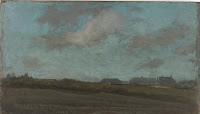 This is a quiet, contemplative show. Physically the paintings are exquisitely delicate and spare, bordering on the austere. There are passages where Whistler seems to allow the milky paint to almost puddle in place, into a cloud here, a wave there, like a watercolorist. I’m guessing they are a conservator's nightmare (as thin as the paint is, you almost feel like you need to step softly in the gallery so as not to shake the paint off the panels.) The color is subdued, though not dull. Whistler can make a bluish gray seem a shocking blue simply by how he arranges the notes of color around it. He is a master of edges and tonal relationships. When he paints an ocean he paints its beautiful desolation and vastness, somehow cramming a hundred miles of ocean and air into a tiny panel. When he paints the night (the show contains his smallest nocturne) he comes very close to total abstraction, but then you look for edges and shapes and slowly you find a horizon, then water, then sky. Your eyes adjust to the painting like they adjust to the night.
This is a quiet, contemplative show. Physically the paintings are exquisitely delicate and spare, bordering on the austere. There are passages where Whistler seems to allow the milky paint to almost puddle in place, into a cloud here, a wave there, like a watercolorist. I’m guessing they are a conservator's nightmare (as thin as the paint is, you almost feel like you need to step softly in the gallery so as not to shake the paint off the panels.) The color is subdued, though not dull. Whistler can make a bluish gray seem a shocking blue simply by how he arranges the notes of color around it. He is a master of edges and tonal relationships. When he paints an ocean he paints its beautiful desolation and vastness, somehow cramming a hundred miles of ocean and air into a tiny panel. When he paints the night (the show contains his smallest nocturne) he comes very close to total abstraction, but then you look for edges and shapes and slowly you find a horizon, then water, then sky. Your eyes adjust to the painting like they adjust to the night.
There is one particular seascape that, to me, is sublime:
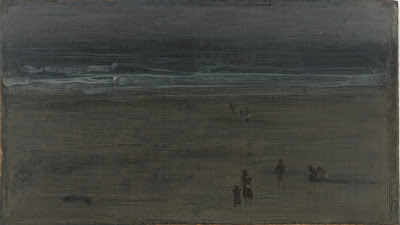 This painting is easy to miss. At first blush it looks as though he started a seascape and then decided to wipe it off-- the image seems to emerge from the gesso like an underexposed painterly Polaroid. The edges dissolve away, at least partially because of the notches in the easel into which he slid the panel. The ground is very dark, maybe raw umber, and the paint is streaky and thin. The wispy ropes of whitish paint that make up the breaking waves are wonderfully opalescent, like liquid pearl. The figures are ghostly, mere silhouettes imprinted against the backdrop of the sand. I had a strange tangent of thought when I saw those figures: a photo in Hiroshima after the explosion-- the cast shadow of a man and his ladder burned onto a wall (see below.) This painting, and many of the others, have a sweet, sad and somehow haunting distance to them. They are faded memories. I get the same feeling from those old daguerotypes (see below) or silent movies where scratches and faded edges create a kind of dusty window pane through which we can see into the past. Upon further study, those seemingly simple figures reveal themselves to be carefully painted. The ones in the foreground appear to be, like us, simply appreciating the sea. One is in a long dress with hands clasped behind her back. Two are sitting in the sand. There are three of people making their way to the waters edge, one with white shorts, and a child. There is little sound in this painting-- maybe the hush of the ocean and the wind, but no voices because we are too far away to hear them. Whistler does little to distract us with his presence-- no bravura brushwork or cleverness for the sake of cleverness. Whistler leaves us alone to stare at the sea.
This painting is easy to miss. At first blush it looks as though he started a seascape and then decided to wipe it off-- the image seems to emerge from the gesso like an underexposed painterly Polaroid. The edges dissolve away, at least partially because of the notches in the easel into which he slid the panel. The ground is very dark, maybe raw umber, and the paint is streaky and thin. The wispy ropes of whitish paint that make up the breaking waves are wonderfully opalescent, like liquid pearl. The figures are ghostly, mere silhouettes imprinted against the backdrop of the sand. I had a strange tangent of thought when I saw those figures: a photo in Hiroshima after the explosion-- the cast shadow of a man and his ladder burned onto a wall (see below.) This painting, and many of the others, have a sweet, sad and somehow haunting distance to them. They are faded memories. I get the same feeling from those old daguerotypes (see below) or silent movies where scratches and faded edges create a kind of dusty window pane through which we can see into the past. Upon further study, those seemingly simple figures reveal themselves to be carefully painted. The ones in the foreground appear to be, like us, simply appreciating the sea. One is in a long dress with hands clasped behind her back. Two are sitting in the sand. There are three of people making their way to the waters edge, one with white shorts, and a child. There is little sound in this painting-- maybe the hush of the ocean and the wind, but no voices because we are too far away to hear them. Whistler does little to distract us with his presence-- no bravura brushwork or cleverness for the sake of cleverness. Whistler leaves us alone to stare at the sea.
(left to right) Daguerotype of The Alamo, Hiroshima:
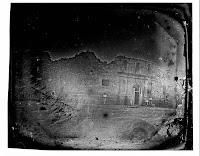

more paintings from the show:
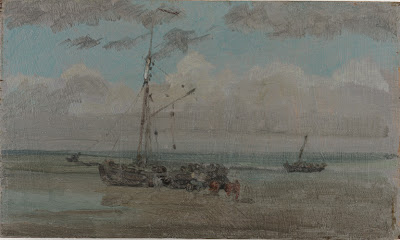
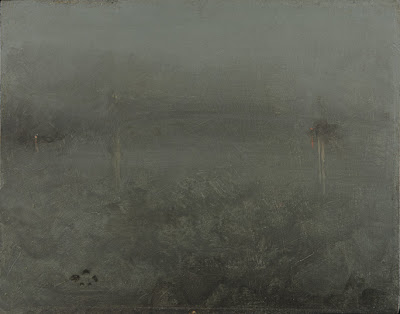
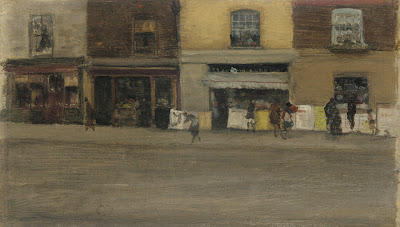
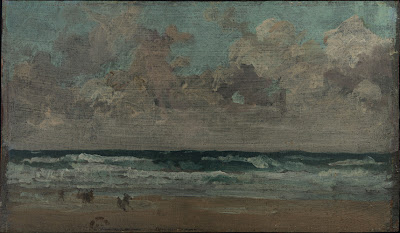
--
Posted By Duane to On Painting at 12/31/2007 03:18:00 PM
 This is a quiet, contemplative show. Physically the paintings are exquisitely delicate and spare, bordering on the austere. There are passages where Whistler seems to allow the milky paint to almost puddle in place, into a cloud here, a wave there, like a watercolorist. I’m guessing they are a conservator's nightmare (as thin as the paint is, you almost feel like you need to step softly in the gallery so as not to shake the paint off the panels.) The color is subdued, though not dull. Whistler can make a bluish gray seem a shocking blue simply by how he arranges the notes of color around it. He is a master of edges and tonal relationships. When he paints an ocean he paints its beautiful desolation and vastness, somehow cramming a hundred miles of ocean and air into a tiny panel. When he paints the night (the show contains his smallest nocturne) he comes very close to total abstraction, but then you look for edges and shapes and slowly you find a horizon, then water, then sky. Your eyes adjust to the painting like they adjust to the night.
This is a quiet, contemplative show. Physically the paintings are exquisitely delicate and spare, bordering on the austere. There are passages where Whistler seems to allow the milky paint to almost puddle in place, into a cloud here, a wave there, like a watercolorist. I’m guessing they are a conservator's nightmare (as thin as the paint is, you almost feel like you need to step softly in the gallery so as not to shake the paint off the panels.) The color is subdued, though not dull. Whistler can make a bluish gray seem a shocking blue simply by how he arranges the notes of color around it. He is a master of edges and tonal relationships. When he paints an ocean he paints its beautiful desolation and vastness, somehow cramming a hundred miles of ocean and air into a tiny panel. When he paints the night (the show contains his smallest nocturne) he comes very close to total abstraction, but then you look for edges and shapes and slowly you find a horizon, then water, then sky. Your eyes adjust to the painting like they adjust to the night.There is one particular seascape that, to me, is sublime:
 This painting is easy to miss. At first blush it looks as though he started a seascape and then decided to wipe it off-- the image seems to emerge from the gesso like an underexposed painterly Polaroid. The edges dissolve away, at least partially because of the notches in the easel into which he slid the panel. The ground is very dark, maybe raw umber, and the paint is streaky and thin. The wispy ropes of whitish paint that make up the breaking waves are wonderfully opalescent, like liquid pearl. The figures are ghostly, mere silhouettes imprinted against the backdrop of the sand. I had a strange tangent of thought when I saw those figures: a photo in Hiroshima after the explosion-- the cast shadow of a man and his ladder burned onto a wall (see below.) This painting, and many of the others, have a sweet, sad and somehow haunting distance to them. They are faded memories. I get the same feeling from those old daguerotypes (see below) or silent movies where scratches and faded edges create a kind of dusty window pane through which we can see into the past. Upon further study, those seemingly simple figures reveal themselves to be carefully painted. The ones in the foreground appear to be, like us, simply appreciating the sea. One is in a long dress with hands clasped behind her back. Two are sitting in the sand. There are three of people making their way to the waters edge, one with white shorts, and a child. There is little sound in this painting-- maybe the hush of the ocean and the wind, but no voices because we are too far away to hear them. Whistler does little to distract us with his presence-- no bravura brushwork or cleverness for the sake of cleverness. Whistler leaves us alone to stare at the sea.
This painting is easy to miss. At first blush it looks as though he started a seascape and then decided to wipe it off-- the image seems to emerge from the gesso like an underexposed painterly Polaroid. The edges dissolve away, at least partially because of the notches in the easel into which he slid the panel. The ground is very dark, maybe raw umber, and the paint is streaky and thin. The wispy ropes of whitish paint that make up the breaking waves are wonderfully opalescent, like liquid pearl. The figures are ghostly, mere silhouettes imprinted against the backdrop of the sand. I had a strange tangent of thought when I saw those figures: a photo in Hiroshima after the explosion-- the cast shadow of a man and his ladder burned onto a wall (see below.) This painting, and many of the others, have a sweet, sad and somehow haunting distance to them. They are faded memories. I get the same feeling from those old daguerotypes (see below) or silent movies where scratches and faded edges create a kind of dusty window pane through which we can see into the past. Upon further study, those seemingly simple figures reveal themselves to be carefully painted. The ones in the foreground appear to be, like us, simply appreciating the sea. One is in a long dress with hands clasped behind her back. Two are sitting in the sand. There are three of people making their way to the waters edge, one with white shorts, and a child. There is little sound in this painting-- maybe the hush of the ocean and the wind, but no voices because we are too far away to hear them. Whistler does little to distract us with his presence-- no bravura brushwork or cleverness for the sake of cleverness. Whistler leaves us alone to stare at the sea.(left to right) Daguerotype of The Alamo, Hiroshima:


more paintings from the show:




--
Posted By Duane to On Painting at 12/31/2007 03:18:00 PM
Reply all
Reply to author
Forward
0 new messages
